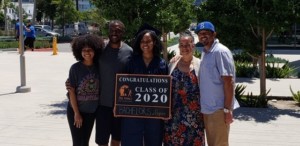Career Education: Even College Grads Should be Employable

There are two employability gaps in this country. The first is a technical skills gap that–despite high unemployment rates–leaves 3 million job openings unfilled.
The second gap is more dispositional. A survey of chief executives makes it clear that work ethic is the #1 priority. The next four priorities describe the demands of the new workplace—teamwork, decision-making, critical thinking and computer literacy. The “3 Rs” come next on the priority list.
Most family wage jobs require some postsecondary education or training. These jobs also require the skills and dispositions which are not explicitly taught in most high schools or higher ed degree programs. Parents with boomerang kids in the basement have learned that even college graduates should possess skills and dispositions that make them employable. A third of graduates feel that their college education did not prepare them well for employment.
Learning is becoming increasingly mobile, modular, and student centered. Time bound courses and credits are slowly giving way to personalized pathways where students progress as they show what they know. New tools are making possible new online and blended learning formats. The need for better employability and the new opportunities of digital learning make it a great time for cities and states to rethink career education.
After years of slow decline in career and technical (CTE) enrollment, there is growing nationwide interest in high quality job preparation. But there is a persistent myth that CTE is the solution for the lowest performing kids at the lowest performing schools when, in reality, it can be a great fit for any student. It may be a more focused and accelerated path to employment but, as high school expert JoEllen Lynch puts it, “CTE is a higher bar — not a lower bar.” This suggests that for all students, job #1 is to “double down on efforts to engage high quality literacy and numeracy,” according to Lynch.
After doubling down on the basics, there are 10 strategies to boost employability–5 for all students and 5 strategies to improve career and technical education.
Strategies for All Students
1. Encourage career awareness in grades 6-12. States and/or districts should encourage all secondary schools to incorporate career awareness into advisory curriculum and make career education resources available to all students. (See Core & More: Guiding & Personalizing College & Career Readiness). Starting in middle grades, students should be goal setting and link job options with educational pathways. Advisors (and advisory systems) should track progress and provide decision support (e.g. Summit Public Schools).
2. Expand course choice with an emphasis on CTE. Louisiana Course Choice is a great example of a state proactively seeking expanded online CTE courses linked to emerging job clusters.
3. Expand work based learning for all students in grades 6-14. All students should graduate having experienced success in a career setting. Jobs for the Future outlined best practices in work based learning including assessment and feedback; work experiences that progress from introductory to advanced; mentoring and leadership development opportunities; and a digital portfolio to capture evidence and artifacts.
4. Applied learning experiences ask teams of students to struggle with real world problems. Examples include Reynoldsburg capstone super blocks; METSA New Tech capstone, presentations of learning at High Tech High, and intensive, nine-week interdisciplinary courses at NYC iSchool.
5. Improve work skills. Most college graduates lack basic employability–work ethic, business analytics and communication, and design thinking. Programs like General Assembly, Koru, and Fullbridge are filling the gaps left by K-16 education.
Strategies to Strengthen CTE Initiatives
6. CTE flex academies linked to emerging job clusters. GPS Eduaction Partners is a network of manufacturing flex academies in the upper midwest. Career Path High near Salt Lake City is an early college flex high school at an applied technology training center.
7. 9-14 CTE schools like P-TECH computer science schools in Chicago and New York combine high school, work experiences and an associate’s degree–with a good shot at a good job.
8.Making stuff can get kids excited about careers. There is a growing range of K-12 coding resources, Maker Faire (see a recap of Portland’s #iPDX14), and and DIY activities. Baltimore’s Digital Harbor Foundation is making hands-on learning available after school and during the summer. The Project Lead The Way program offers applied hands-on STEM learning in engineering, biomedical science, and computer, along with post-secondary credit for students who qualify. FIRST is a great robotics competition.
9. Competency-based learning is expanding in postsecondary and beyond. The more dynamic the job category the more providers there are and the more alternative market signaling (i.e., badges, alternative credentials) is evident. Check out P2PU, the “university for the web.”
10. Lifelong career education is becoming the norm as jobs change as fast as new technologies. Every adult should be part of a lifelong learning network. States could encourage colleges and universities to consider a lead role in lifelong learning–with a small investment and ongoing industry partnerships, it could be a self-sustaining line of business. Udemy for organizations is powering lifelong career learning for thousands of companies and nonprofit associations.
Boosting employability is something people with even the most divergent viewpoints can typically rally around. P-12, Higher Education, Chambers of Commerce, and policy makers all care about this issue and have a vested interested in making a difference. Integrating career education, career planning and employability creates the perfect opportunity for focused partnerships and policy. The best partnerships leverage common interests and initiatives that offer a positive result at the individual, organization and partnership level.
From a student perspective, we need to illuminate for them the many options and educational paths they might consider. Since most require some form of post-secondary education and training, we ought help them figure out the cost-benefit of their options.
Leaders in every region of the country recognize the need skill up fast–and not just to promote economic vitality of students and communities, but to address rising inequality, to build the quality of life, and to build civic participation.
General Assembly and Udemy are portfolio companies of Learn Capital where Tom is a partner.








Barbara Pazey
Would be interested in knowing whether all student populations are prepared for college and career including students with disabilities.
Replies
Tom Vander Ark
That's the goal!
Rachel Klein
I'm so glad to see this post, Tom. After talking to many students in my first year in Highline Public Schools, I realized that we had forced kids into a college path and they were having a visceral negative reaction. "But I hate school! Why would I pay to go on for more?" So this year we took all the 9th graders at Highline HS to visit a workplace, like Microsoft, Google, Fred Hutchinson Cancer Research Institute. Here are some of their responses:
• “We should do this every year and try other careers so we have more career choices after college.”
• “The best part was seeing the working environment and seeing the cool things they use.”
• “Trips like this help us explore the different careers…it gives us an opportunity to get a taste of what it’s like.”
Even if all we do is help them rule out some potential options, we've likely saved them months or years of whiling away in college courses they aren't ever going to need, and we've jump-started their thinking by making a "career" more of a real thing.
Let's not forget about a couple of other organizations doing great work in this area: National Academy Foundation and ConnectEd.
Thanks!
Replies
Tom Vander Ark
9th grade career awareness field trips is such a great idea!